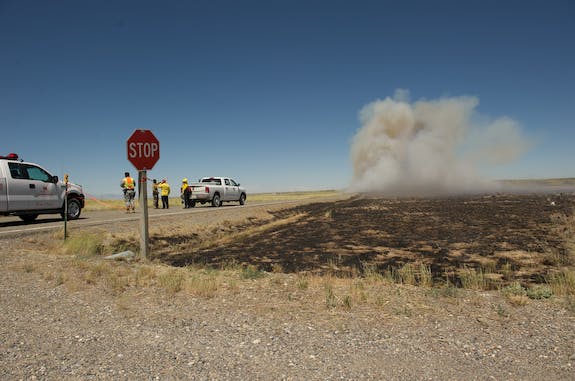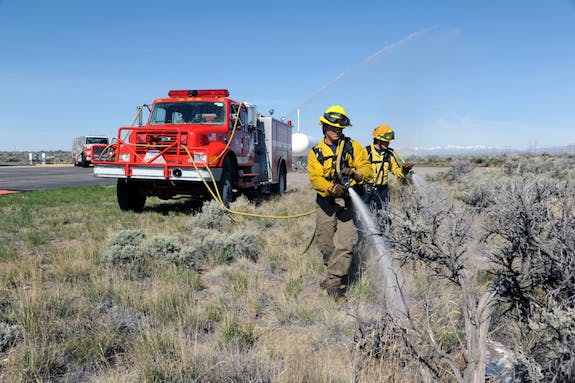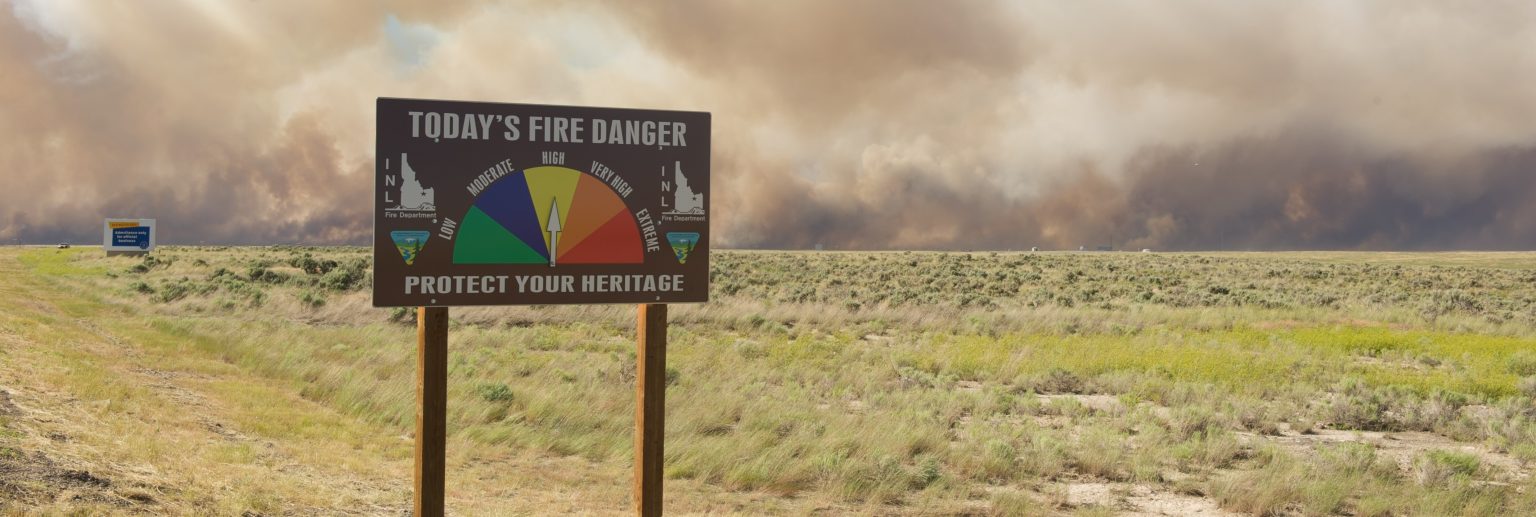Most INL Site employees take a nice nap on the bus ride to and from facilities. There usually isn’t much to see on INL’s 890+ square miles of desert land except clumps of sagebrush and the occasional antelope that leaps across the highway, causing the bus driver to tap on the brakes and snap the tired employees out of their restful states. But with the most intense heat and dryness of Idaho summers still looming ahead, danger lurks on that peaceful landscape.
Wildland fire season has arrived at the Idaho desert. Fortunately, the INL Fire Department is ready to help employees stay safe during this high-threat time period. Every spring, the department reviews its fire preparation procedures and the lessons learned from past fire seasons to ensure it is well prepared to grapple with the blazes that tear through the grass and sagebrush of the desert Site.
Since 1994, the INL Site has averaged five fires a year and about 12,000 acres burned, with no significant facilities damaged due to its strong defensible buffer zones. The largest fire in recent years was the 2010 Jefferson Fire, which burned over 100,000 acres, and the last major fire was 2012’s Midway Fire, which consumed more than 8,000 acres. This summer, INL has already experienced three wildland fires, the largest involving over 80 acres.

“A lot of people and organizations engage every year to make sure things are ready to go for wildland fire season. Those activities have been completed and we’re ready to go,” said INL Fire Chief Eric Gosswiller. He and all fire department employees know they can never be too thorough when conducting inspections on the Site, especially those involving vegetation and defensible space.
A big part of their spring preparation procedures is the wildland vegetation assessment, and vegetation management often continues into the early summer season. This process involves looking at each campus on the Site to ensure that there is enough defensible space, meaning areas that contain little or no fire fuel, surrounding all facilities.
“We have very defined criteria on how much defensible space is enough,” Gosswiller explained.
Other aspects of this spring preparation include reviewing past procedures, training personnel, assessing equipment readiness, interfacing with the Bureau of Land Management (BLM) to test radio frequencies, and communicating fire danger to all employees. During fire season, the department reviews the wildland fire forecast each morning and validates its equipment daily.
Due to an increase in the growth of sagebrush, combined with the relatively calm fire seasons in the past five summers, wildland fire potential is high this summer.
“In my 26 years at INL, I have only seen one other time where there has been this significant a gap between [heavy] fire seasons. The amount of vegetation on the Site available to burn is as high as I’ve seen,” said Gosswiller.

INL’s fire department is well trained, and members have extensive experience fighting the relatively frequent wildland fires that rage through the high desert. The department also has reciprocal partnerships with the BLM, Forest Service, and several regional fire departments. They are well-equipped with four Type 4 wildland fire engines, one Type 6 wildland fire engine, a 3,000-gallon water tender, and compressed-air foam systems. At least 22 fire department staff members are always on duty, and if necessary, additional off-duty individuals can be called in for emergencies, bringing that number up to 75.
Gosswiller is “very confident in the capabilities of fire personnel. We have experienced folks who make good decisions. They view each fire as a learning opportunity to further improve…response tactics while ensuring firefighter safety.”
Though the fire department is well prepared for the danger of this season, Gosswiller wants to remind everyone that may be traveling through the Site of their importance to fire safety. It is most often a member of the public or another INL Site worker who initially reports wildland fires, and both 911 and 208-526-7777 are good numbers to call for anyone who sees evidence of a wildland fire.
Gosswiller appreciates the firefighting team, the Emergency Response Organization, Roads and Grounds, and countless others who come together particularly during wildland fire season to prepare and to ensure the safety of employees and facilities.
The chief’s best advice to all INL employees is to avoid complacency and be on high alert for wildland fire potential during every minute of their daily work.
“Have a healthy respect for what can go wrong,” he said. “Be aware that we have significant fire danger. This will drive conservative decision-making in your planning and operations, and help prevent a wildland fire.”





